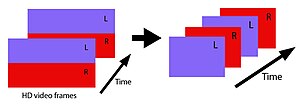DVB 3D-TV
This article's factual accuracy may be compromised due to out-of-date information. (January 2012) |

DVB 3D-TV is a new standard that partially came out at the end of 2010 which included techniques and procedures to send a
Nowadays 3D television technology is already in its first steps regarding its standardization, now the major 3D market is in
Implantation
The implantation of first generation of DVB 3D-TV will be staggered:
- Phase 1: the first standard will have signaling or distribution formats should not prevent future expansion to support new 3D encoding formats. This system only works with stereoscopic Frame sequential 3D systems. Requirements for this system, which is called Frame compatible format, are included in the commercial requirements of DVB. Some broadcasters like Sky3D[1] or Canal+3D[2] are already using this technology, which is largely thought for PayTV.
- Phase 2: the use of new broadcasting requirements for specific 3D streams won't be compatible with actual 3D STB, but it would be service compatible with 2D STB if no specific 3D STB is available by using Scalable Video Coding and Multiview Video Coding techniques, i.e. not having to simulcast 2D and 3D and occupying only one channel by using a unique video stream with a normal 2D base stream and an adjustable 3D depth layer. This system is called service compatible and is designed for Free-to-air group of broadcasters.
3DTV signals

Matrix of signal formats for 3DTV:
| Compatibility level | 1st generation 3DTV | 2nd generation 3DTV | 3rd generation 3DTV |
|---|---|---|---|
| Level 4: | 2D HD + MVC (L,R formed by matrixing: depth info) | 2D HD + MVC (Depth, occlusion and transparency data) | |
| Level 3: | Frame compatible + MPEG resolution extension (ex. SVC) | ||
| Level 2: | L and R in same HD frame | ||
| Level 1: | Color anaglyph
|
Frame sequential

Regarding how a signal once it's decoded is sent to the
Technical features
Frame compatible
In Phase 1 system, only frame-sequential 3D is allowed, using
There are basically two ways to do spatial multiplex: Side by side and Top and bottom, but additional spatial multiplex formats have been proposed in order to improve picture quality by providing a better balance between the V and H resolution.
Side by side

Side by side (SbS) format just put the left and right images one next to the other in an HD image. Because of this, a horizontal
- 1080i @ 50 Hz Side-by-Side
- 720p @ 50 Hz Side-by-Side
- 720p @ 59.94 / 60 Hz Side-by-Side
- 1080p @ 23.97 / 24 Hz Side-by-Side
- 1080i @ 59.94 / 60 Hz Side-by-Side
Top and bottom

Top and Bottom (TaB) format put left and right images one above the other in a HD image. In this case, vertical
- 1080p @ 23.97 / 24 Hz Top-and-Bottom
- 720p @ 59.94 / 60 Hz Top-and-Bottom
- Not every spatial multiplex format is frame compatible with actual systems. Following formats are non frame compatible:
- 720p @ 50 /60 Hz
- 1080p @ 24 Hz
Graphics and text
There are basically two types of text displayed on screen that need additional broadcasting information to be displayed on a 3D display:
- Subtitling: (or DVB subtitling implementations and will be backward compatiblewith 2D streams.
- Service guide: the service information. Depth information will be extracted of the captions, displaying the graphics in the same depth.
Signaling
The main function of signaling for
3DTV broadcast in future
Multiview
Multiview video coding is a compression standard appended from
Free viewpoint
Total
See also
- 3D Television
- DVB
- 3D display
- 3-D film
- Digital 3D
- Stereoscopic Video Coding
- 3D Blu-ray Disc
- EPG
- Free viewpoint television
- Multiview Video Coding
References
- DVB 3D-TV seminar presentation by David Wood: available at [2]
- ^ "Sky 3DTV site". Retrieved 2010-12-02.
- ^ "Canal+3D site". Archived from the original on 2010-10-02. Retrieved 2010-12-02.
- ^ "MVC 3D signal broadcast". Fraunhofer society. 2010. Retrieved 2010-12-02.
